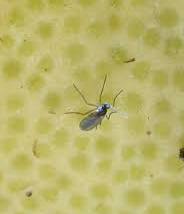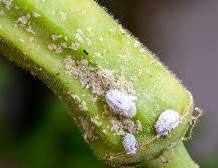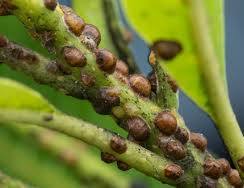to identify and treat indoor plants pests are very important.These pests are very common.We understand your worry. Yes, pests can be extremely dangerous to your indoor plant health. Not only does it weaken the growth but if not treated properly can cause the death of plants. In this blog, we are discussing some common pests and their treatment. Enjoy your reading and have fun.
Fungus Gnats

They are flying insects sometimes mistaken as insects. Fungus Gnats have a smaller size with long, slender legs.
It is attached to the soil and in the larva stage eats fungi and decaying organic material.
How to identify the fungus gnats?
They are small in size and prefer moist soil. They usually don’t hang around but prefer foliage and soil.
In the larval stage, it is hard to identify them and in this stage, they love to eat fungi and hang around the roots. In large stages, they are more dangerous to your plant than the adults.
Symptoms shown by plants infected by fungus gnats
Your plant can show different symptoms when under stress by fungus gnats. From distorted growth to discolored and wilted foliage, your plant can show those stress conditions.
How to get rid of fungus gnats?
There can be various effective ways to control fungi gnats. But in trying to eliminate them you should target larvae because, in the larva stage, they cause the problem. Adults are moving from plant to plant, it is hard to fix them.
We recommend using Mosquitoes Bits. Mosquitoes bits can either be mixed with soil or sprayed on the surface of the soil.
Be sure that you don’t overwater your plants because they are happy in moist soil. Regularly inspect your plant. We recommend changing the potting mix and reporting the plant if necessary. Make sure that you use the right potting fertilizer to prevent the fungus growth and prevent your indoor plants pests.
There are a variety of plants susceptible to fungus gnats like Geranium, lilies, and begonias.
Mealybugs
Mealybugs are small insects with soft bodies. They crawl and move slowly. They are white and appear fuzzy with a wax coating on their body. The female lays eggs in a sac-like structure and after laying eggs about 300-600 will die. The Nymph will travel and eventually hatch but the young ones will find a suitable feeding place.

There can be different Mealybugs like Mixecan Mealybugs, Root Mealybugs, and long-tailed Mealybugs.
Plants like succulents, fruits, and vegetable crops, are more susceptible to Mealybugs growth.
How to spot Mealybugs?
Mealybugs prefer hidden spots. Observe your plant, if you find white clusters, it may be a cotton-like excretion consisting of Mealybugs sacs. Remove the cotton structure and examine if it is Mealybugs.
They often infect new growth.
Symptoms shown by plants
Mealybugs-infected plants will show different symptoms ranging from chlorosis, loss of flower boxes, deformed growth, and yellow or wilted leaves.
How to prevent Mealybugs?
Inspect your plant regularly, check out for white clusters, and remove them if spotted. Also, avoid nitrogen-rich fertilizers and apply horticultural oil regularly because Mealybugs prefer nitrogen for growth, and horticultural oil discourages the growth of Mealybugs.
We recommend pruning the infected parts in an extreme case, using insecticidal spray or soap, and spraying the plant by cleaning the leaves.
Scale
Scale is also in an insect. It is brown in color and round or flat, very hard to find. It usually resides between stems. They will look like small scab-like spots on your plant.

There are more than 8000 species of scales and they are extremely damaging to plants. They can feed on leaves, stems, and branches.
They have a shell-like coating protecting their body. Females hatch the eggs and it takes 1-3 weeks to hatch eggs.
There are different types of Scales such as Armored Scale and they feed on outdoor plants.
Soft Scales are found in green and lush environments and infect indoor plants. Evergreen shrubs, woody plants, and fruit trees are more susceptible to infection from Scales.
Presence of scales
Watch out for your plant. If the leaves show discoloration it may be due to the presence of scales. Also, Scales are immobile and found in clusters as tiny shell-like bumps.
The scale will extract the sap of the plant causing cellular damage.
Symptoms shown by plants
The extraction of sap means that Scales will use the nutrients of plants and deprive plants of using those nutrients. Plants will show yellow leaves, wilted leaves, and distorted growth.
Also, it affects photosynthesis by making sooty mold on the top of leaves.
How to prevent Scales?
We recommend washing leaves with a mild solution and soap. It is better to use insecticidal soap. Also, gently remove the pests with a cotton cloth or brush and make sure that the plant does not hurt. If the infection is severe, quarantine the infected plants in isolation.
Spider Mites
The most common pest found in an indoor garden is Spider Mites. Spider Mites are very small and difficult to spot because of their small size. They are brown, red, green, and yellow.

The female lays hundreds of eggs, and after spring they emerge and feed on plants. They reproduce quickly. And this exponential growth is very dangerous to a plant’s health.
How to identify Spider Mites in Plants?
In winter they lay eggs and produce new ones. In summer they feed on plants. They mature and become adults in 1-2 weeks.
Inspect your plant closely. Identify the type of disease and find out whether it is caused by insects or arachnids. Look for the telltale signs of the Spider Mites activity. The webbing will be there under the leaves and branch intersection.
Symptoms Shown by plant
The plant will become weakened and unsightly, the leaves will turn yellow, the foliage will be distorted, and the flowers and leaves may start to deform.
How to prevent Spider Mites?
We recommend high soil, meaning fertilizer-rich soil. Keep the area around the plant clean. Spider Mites thrive in dry conditions so keep the area humid. Avoid chemical pesticides but you can use them in extreme cases. Spray the plant with water and use organic insecticidal soap. Also, use Neem oil which is a general pest repellent.
How do you know if your houseplants have pests?
Inspect your plant daily to identify and treat indoor plants pests . Note down the plant growth and health. If it shows certain signs like yellowing leaves, distorted foliage, or weakened growth, then it might be due to pests. Check out and take appropriate measures.
How to use neem oil on plants?
Mix Neem oil with water and add soap which will help to mix the water and oil. Spray it gently on the surface of plant leaves. It will work as a repellent for pests.
What is eating the leaves of my indoor plant?
Spider mites, caterpillars, and fungal diseases might be the reasons for unhealthy leaves. They often eat leaves and wilt them. You can use different insecticides to avoid it.
What is the most common method of pest control?
There are different methods available to control pests but the most commonly used are Chemical methods. They are used to control diseases in crops. It will often lead to healthy and strong plants.
How do you diagnose indoor plant leaves?
This depends on the type of indoor plant disease if it is a nutritious deficiency then fertilize the soil, if it is insects or pests then use insecticides or pesticides which will eventually lead to healthy leaves.
Final thoughts
Indoor plants need regular inspection. Pests can create big problems by posing danger to indoor plants. Mealybugs, spider mites, and scales can be very dangerous to plant health and may cause plant death. However, if treated properly, it can be prevented, and plants should resume their proper health so it is very important to identify and treat indoor plants pests.
